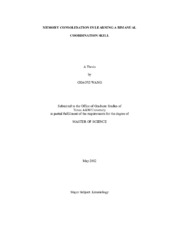| dc.description.abstract | The present study was conducted to examine the process of consolidation when learning a difficult bimanual coordination pattern. There are two phenomena associated with the process of consolidation, an enhancement in performance without additional practice and the stabilization observed as resistance to interference from a similar task after acquisition of a novel skill. Both phenomena have been widely examined in sequence skill learning studies. However, few studies have examined the consolidation effect after training of a continuous and rhythmic bimanual coordination pattern. The first goal of this study was to determine if sleep enhances the performance of a minimally trained 1:2 pattern of bimanual coordination in a manner that has been observed with sequencing skills, that is, performance significantly improves after an overnight sleep. A recent study by Buchanan & Wang (in-press) showed that by manipulating the position of a visual-augmented-feedback cursor, either behind or to-the-side of a 1:2 bimanual coordination template, an advantage of the side cursor position was found in the no-feedback retention test after a fifteen-minute break. The second goal was to test whether an overnight sleep may reduce the guidance effect associated with the behind cursor position as reported in Buchanan & Wang (in-press). In the present experiment, the effect of an overnight sleep on learning a 1:2 pattern of bimanual coordination was accessed with six test trials presented immediately (IMM group) or 24 hours (SLEEP group) after 5 minutes of practice. The test trials included three trials with feedback and three trials with feedback removed. For either the IMM or SLEEP group, half of the participants practiced with the behind cursor position and the other half practiced with the side cursor position. The results indicated that the SLEEP group showed an improvement in performance from the acquisition trials to the feedback test trials whereas the IMM group did not. The advantage of the side cursor position at the no-feedback retention test was not evident in the current study. These results are consistent with our two predictions and provide evidence of enhancement in learning a 1:2 pattern bimanual coordination skill. | en |


